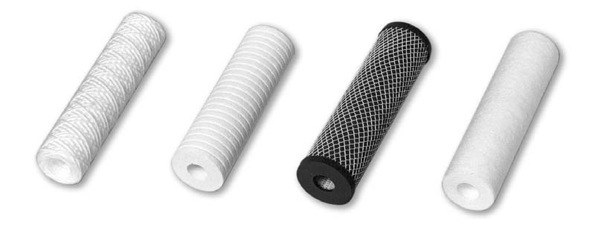Particle Filters
Particle filters are used to prevent the build up of deposits on gold cavities, flashlamps, flow tubes, the cooling loop, and all associated plumbing.
 Particle filters have a nominal pore size, usually in the .2 – 10 micron range. Most laser systems use depth filters which are relatively inexpensive and filter throughout their bulky cross section. These entrap most but not all particles above the rated pore size. Some systems use the more expensive screen type, absolute filters. Screen filters entrap particles on the surface of the filter and remove all particles at or above the rated pore size.
Particle filters have a nominal pore size, usually in the .2 – 10 micron range. Most laser systems use depth filters which are relatively inexpensive and filter throughout their bulky cross section. These entrap most but not all particles above the rated pore size. Some systems use the more expensive screen type, absolute filters. Screen filters entrap particles on the surface of the filter and remove all particles at or above the rated pore size.
Particle filters should be changed on a regular maintenance schedule at least once every 6 months, or sooner if an increase in pressure drop across the filter indicates clogging.
The processes involved in generating and developing a laser beam create a great deal of waste heat. This heat must be rapidly carried away to maintain laser efficiency and prevent damage to critical components such as lamps, rods and gold cavities in Nd:YAG lasers, and mirrors in CO2 lenses. Many CO2 lasers use oil to cool plasma tubes and other components, however, in most high powered industrial lasers, water is used as the cooling agent. Usually some sort of water-to-water heat exchanger is employed.
The water on the laser side of the heat exchanger must be filtered to prevent contamination buildup and electrical arcing. Two types of filters are used: particle filters and deionization filters.
Other system cooling components include pumps and pump components such as impellers and volutes, heat exchangers, valves and fitting and various seals, seats and O-Rings.
